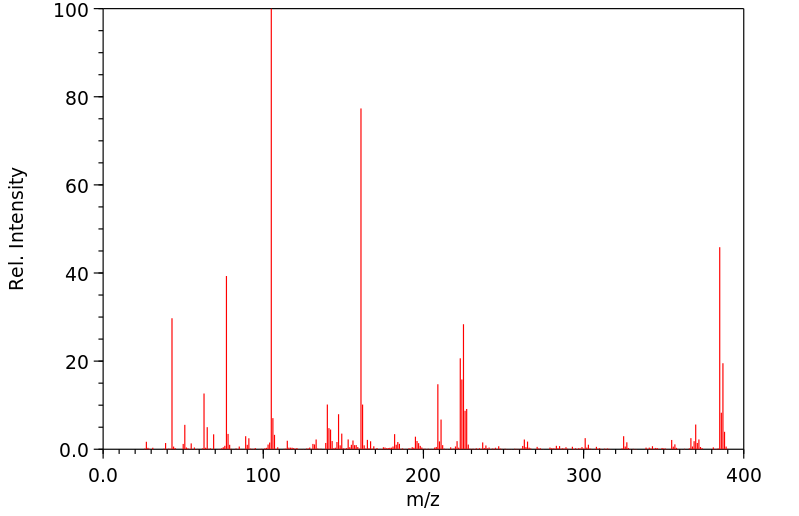copper(II) benzoylacetonate
中文名称
——
中文别名
——
英文名称
copper(II) benzoylacetonate
英文别名
bis(benzoylacetonato)copper (II);Cu(bzac)2;copper;(Z)-3-oxo-1-phenylbut-1-en-1-olate
CAS
——
化学式
C20H18CuO4
mdl
——
分子量
385.907
InChiKey
IIPJCJBKVVFLHI-CVMHYBSASA-L
BEILSTEIN
——
EINECS
——
-
物化性质
-
计算性质
-
ADMET
-
安全信息
-
SDS
-
制备方法与用途
-
上下游信息
-
文献信息
-
表征谱图
-
同类化合物
-
相关功能分类
-
相关结构分类
计算性质
-
辛醇/水分配系数(LogP):1.95
-
重原子数:25
-
可旋转键数:4
-
环数:2.0
-
sp3杂化的碳原子比例:0.1
-
拓扑面积:80.3
-
氢给体数:0
-
氢受体数:4
反应信息
-
作为反应物:描述:copper(II) benzoylacetonate 在 一水合肼 作用下, 反应 2.0h, 以93%的产率得到3-甲基-5-苯基-1H-吡唑参考文献:名称:Nitrogen-containing heterocycles from metal β-diketonates摘要:Factors determining the reaction of metal beta-diketonates with hydrazine, in particular the nature of central metal ion and structure of beta-diketonate ligand, are discussed. The possibility for the preparation of other heterocyclic compounds via reaction of metal acetylacetonates with phenylhydrazine, o-phenylenediamine, urea, and thiourea was studied.DOI:10.1134/s1070363211040244
-
作为产物:描述:以 neat (no solvent) 为溶剂, 生成 copper(II) benzoylacetonate参考文献:名称:The molecular structures and magnetic properties of μ3-tetranuclear β-diketonate copper complexes [Cu(bzac)(μ3-OC2H4OCH3)]4 and [Cu(μ-dbm)(μ3-OC2H4OCH3)]4摘要:[Cu(bzac)(OC2H4OCH3)]4dagger (I) and [Cu(dbm)(OC2H4OCH3]4dagger (II) have been shown to be tetrameric in the solid state. Compound I has a pseudo-cubane type structure with mu3-alkoxide oxygens occupying four bridging positions. Two methoxy oxygens are also within bonding distance of copper(II) ions. Compound II has a stepped configuration with a chelate ring and alkoxide oxygens as bridging centres. None of the methoxy oxygens is clearly chelating. Magnetic susceptibility data versus temperature data to 4 K for the complexes show antiferromagnetic coupling which can be treated by ''pairs of equal dimers'' procedures. The complexes decompose in stages at temperatures below 350-degrees-C at atmospheric pressure to give CuO.DOI:10.1016/s0277-5387(00)81471-0
-
作为试剂:描述:参考文献:名称:Catalyst composition and method for chlorinating aromatic compounds摘要:芳香族化合物,如甲苯和邻二甲苯在存在催化剂组合物的情况下进行氯化,所述催化剂组合物由(A)至少一个盐和(B)至少一个有机硫化合物组成,其中盐包括从4至12族金属、镧系元素和锕系元素中选择的金属和一个对离子,而且(B)优选为苯并噻嗪-N-羰基氯。该催化剂组合物可以包括(A)和(B)的反应产物。在这些条件下,p-氯同分异构体的产生被优化。在某些实施例中,所述对离子是从至少一个酸性有机化合物中选取的有机对离子,所述有机化合物的近似pKa值相对于水至少为3。公开号:US20040186329A1
文献信息
-
Formation and Spectral Properties of Some Bis(β-diketonato)copper(II)–Diazole Complexes作者:Tamizo Kogane、Reiko HirotaDOI:10.1246/bcsj.53.91日期:1980.1The reactions of bis(β-diketonato)copper(II) with pyrazole and imidazole gave the diazole adducts Cu(β-dik)2(Hdzl) (β-dik=β-diketonate anion; Hdzl=diazole) and/or the μ-diazolato complexes [Cu(β-dik)(dzl)]n (n=2,4,….). The complexation reactions are very sensitive to the nature of the diazole and to the reaction conditions, sometimes giving different products depending upon the solvent used. In chloroform
-
Quantitative prediction of nuclear-spin-diffusion-limited coherence times of molecular quantum bits based on copper(<scp>ii</scp>)作者:S. Lenz、K. Bader、H. Bamberger、J. van SlagerenDOI:10.1039/c6cc07813c日期:——
We have investigated the electron spin dynamics in a series of copper(
ii ) β-diketonate complexes both in frozen solutions and doped solids. We simulate the coherence decay quantitatively without fit parameters. -
Bis(benzotriazol-1-yl) methylimine as a novel cyanating agent for labile β-diketonates作者:S. Thambidurai、K. Jeyasubramanian、S.K. RamalingamDOI:10.1016/0277-5387(96)00134-9日期:1996.8Abstract Bis(benzotriazol-l-yl) methylimine was used as a novel electrophilic cyanating agent for labile β-diketonates (M = Cu II , Ni II , Co II , Zn II and Cd II ). The actual cyanating species was 1 -cyanobenzotriazole formed in situ with the elimination of benzotriazole. The labile metal-oxygen bond in the chelates possibly induced debenzotriazolation. The inert and less labile β-diketonates did not
-
Conformational studies of mixed-ligand copper(II) chelates. Crystal and molecular structure of (N,N-dimethyl-N′-ethyl-1,2-diaminoethane-(1-phenyl-1,3,-butanedionato)copper(II) perchlorate作者:Chris Tsiamis、Leandros C. Tzavellas、Constantin A. Kavounis、Christine J. CardinDOI:10.1016/s0020-1693(96)05190-0日期:1997.1The IR and ligand field spectra and the structure of the mixed-ligand compound [N,N-dimethyl-N′-ethyl-1,2-diaminoethane(1-phenyl-1,3-butanedionato)(perchlorato)copper(II)]), [Cu(dmeen)bzac(OClO3)], are reported. The structure was determined by single crystal X-ray diffraction analysis (triclinic, space group ). The structure is square pyramidal with the apical position occupied by one oxygen of the混合配体化合物[ N,N-二甲基-N'-乙基-1,2-二氨基乙烷(1-苯基-1,3-丁二酮基)(高氯根)铜(II)的红外光谱和配体场光谱及结构]),[Cu(dmeen)bzac(OClO 3)]。通过单晶X射线衍射分析(三斜晶系,空间群)确定结构。该结构是方形金字塔形,其顶部位置被四面体高氯酸盐基团的一个氧占据(与铜的距离2.452(5)Å)。苯环的平面倾斜,与β-dionato部分的平面形成16.72(14)°的角度。含氮碱采用扭角为108.72(14)°的gauche构型。乙基是顺式相对于苯基基团的分子,它位于赤道位置,碳氮键的向量与CuNN平面形成143.9(3)°的角。相邻轴向氢与高氯根基团的氧的相互作用导致氢键的形成。红外光谱表明,在固体状态下的溴-或Cl -位移容易CLO 4 -基团。配体场光谱的移动表明极性溶剂沿着垂直于CuN 2 O 2平面的轴参与了与金属中心的供体-受体相互作用。
-
Synthesis and Physico-Chemical Studies of Some Mixed-Ligand Complexes of bis(Benzoylacetonato)copper(II) with Some Biologically Active Heterocyclic Chelating Donors作者:R. C. Maurya、R. Verma、H. SinghDOI:10.1081/sim-120021938日期:2003.1.7Six new mixed‐ligand complexes of copper(II) of the compositions [Cu(bzac)2(L)2], where bzacH = benzoylacetone and L = 3‐methyl‐2‐pyrazoline‐5‐one (MP) (1), 2,3‐dimethyl‐1‐phenyl‐3‐pyrazoline‐5‐one (DMPHP) (3), benzimidazole (BZL) (4) or benzothiazole(BZT) (5) and [Cu(bzac)2(L–L)], where L–L = 4‐amino‐2,3‐dimethyl‐1‐phenyl‐3‐pyrazoline‐5‐one (ADMPHP) (2) or 2‐aminobenzothiazole (ABZT) (6), have been六种新的铜 (II) 混合配体配合物 [Cu(BZac)2(L)2],其中 BZacH = 苯甲酰丙酮,L = 3-甲基-2-吡唑啉-5-酮 (MP) (1) , 2,3-二甲基-1-苯基-3-吡唑啉-5-酮 (DMPHP) (3), 苯并咪唑 (BZL) (4) 或苯并噻唑 (BZT) (5) 和 [Cu(BZac)2(L- L)],其中 L-L = 4-氨基-2,3-二甲基-1-苯基-3-吡唑啉-5-酮 (ADMPHP) (2) 或 2-氨基苯并噻唑 (ABZT) (6),已合成通过双(苯甲酰丙酮)铜(II)与配体 L 和 L-L 的相互作用。如此获得的化合物通过分析数据、摩尔电导、磁测量、ESR、IR和电子光谱研究来表征。建议这些化合物具有单体结构。
表征谱图
-
氢谱1HNMR
-
质谱MS
-
碳谱13CNMR
-
红外IR
-
拉曼Raman
-
峰位数据
-
峰位匹配
-
表征信息
同类化合物
(E)-3-(4-(叔丁基)苯基)丙烯酸乙酯
(E)-3-(2-(三氟甲基)苯基)丙烯酸乙酯
(E)-3-(2,4-二甲氧基苯基)丙烯酸乙酯
(2E)-N-[2-(3-羟基-2-氧代-2,3-二氢-1H-吲哚-3-基)乙基]-3-苯基丙-2-烯酰胺
黄金树苷
鲁索曲波帕
香豆酸肉桂酯
香豆酰多巴胺
香草醛缩丙酮
顺式邻羟基肉桂酸
顺式芥子酸
顺式-曲尼司特
顺式-乙基肉桂酸酯
顺式-N-阿魏酰酪胺
顺式-3,4-二甲氧基苯丙烯酸
顺式-2-((叔丁氧羰基)氨基)-3-(4-氨甲酰基-2,6-二甲苯基)丙烯酸甲酯
顺-o-羧基肉桂酸
顺-2-甲氧基肉桂酸
阿魏酸钠
阿魏酸酰胺
阿魏酸甲酯
阿魏酸甲酯
阿魏酸甲酯
阿魏酸松柏酯
阿魏酸杂质1
阿魏酸异辛酯
阿魏酸哌嗪
阿魏酸二十烷基酯
阿魏酸乙酯
阿魏酸4-O-硫酸二钠盐
阿魏酸-D3
阿魏酸
阿魏酸
阿魏酰酪胺
间羟基肉桂酸
间羟基肉桂酸
间硝基肉桂酸
间甲基肉桂酸
间甲基反式肉桂酸甲酯
间氯肉桂酸
间三氟甲氧基肉桂酸甲酯
间-香豆酸
间-(三氟甲基)-肉桂酸
锂(E)-2-溴-3-苯基丙烯酸酯
钠二乙基2-[(氧代氨基)-苯基亚甲基]丙二酸酯盐
酪氨酸磷酸化抑制剂AG 556
酪氨酸磷酸化抑制剂AG 527
酪氨酸磷酸化抑制剂AG 490
酪氨酸磷酸化抑制剂A46
酪氨酸磷酸化抑制剂 AG 30







